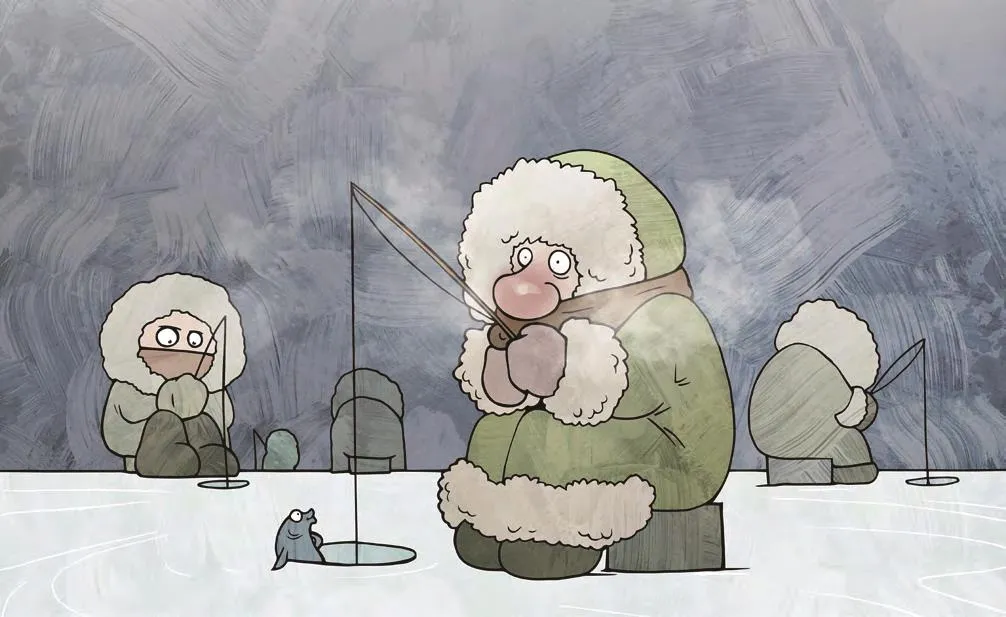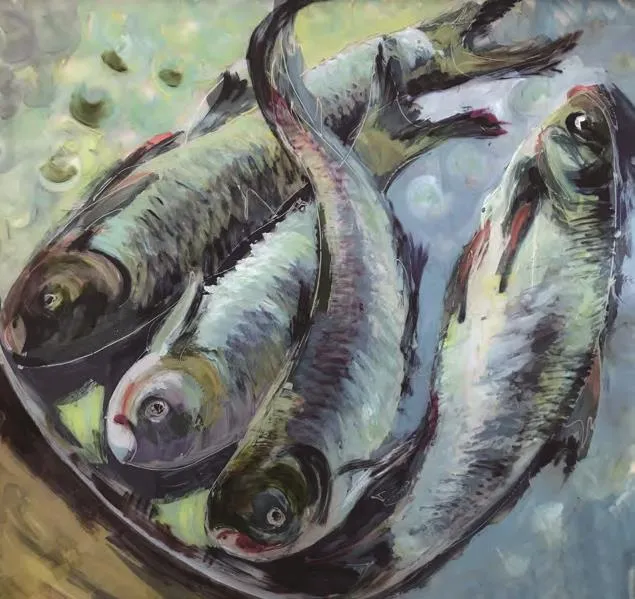Tips on Ice Fishing
2019-08-08ByHaoLinhai
By Hao Linhai
The lake is finally frozen over.
When the thickness of the ice layer reaches 2 inches or so, some bold and anxious men will be ready to rush onto it.Though a dangerous move, it is easier to catch fish when the water starts to ice up (or when the ice starts to melt in early spring). Any veteran ice-fisher knows this.
The most cautious fisher,maybe like me, will not fish until the ice is about 5 inches thick.I will be in my cotton-padded clothes and stand on ice, turning my back to the chilling wind,sticking a line into a single hole.
Choose a Spot and Make the Hole
Where should you make the hole in the ice? Based on my experience, beside the reeds, near a re-frozen crack, above deeper water, or above where the water abruptly deepens are the best spots. But how would I know what it is like beneath the ice? Here are my tips. Drill a small hole in the ice, and put into the hole a plummet tied to the end of a rope(or just stick a reed into the hole),so you can “feel” the bottom. If the place is good, just make the hole bigger; if not, try another place.

Even if you choose the right place, some holes are just“luckier” than other ones. You may catch a lot of fish from one hole, but get literally nothing from the one right next to it.
With an ice chisel and a little bit of skill, a young man can dig a beautiful hole within minutes.An opening as big as a rice bowl is the best; do not make it bigger than that, or you may scare the fish away. The rim of the hole should be cut smooth in case of the fishing line being cut off. Imagine when a big fish bites the hook, and struggles in the water for quite a while, and just before it is exhausted and becomes your rare harvest, the line breaks. Moreover, remember to put the ice debris together so that you're less likely to fall.Falling on ice will be painful, and what's worse, the loud bumping of your buttocks on the ice will be
a caution to the lovely creatures below.
One fishing pole, two or three holes, eight to nine meters from each, rotating around to each of them in turn—that is the normal fishing style of Northwest China.You keep to one hole, put bait in it, and patiently wait. When you feel the fish won't come, just switch to another hole. When I went to Tianjin and Beijing,I saw a different style of ice seek our target all over the world,and once we find one, we could stick to it forever. Sometimes we can find what we call “the Selfless Man's Holes.” They are dug out and then abandoned by some impatient guys who may dig dozens of holes along a very long distance in a day, but catch very few fish. When a more experienced fisher comes and tries one of these abandoned holes, he may catch fish at once!fishing there. The holes they dug were close, and of a fan-shaped distribution, by each of them there was a fishing pole with line wheel and small bracket. The fishers all put a warm water bag or something to the chest, sitting on a stool. For a moment I felt like that they would operate a promising industry.

We Northwest fishermen are more like “roving bandits.” We Of course, most “selfless men” are newbies—energetic, but impatient and young.
The Floating Game
The experience of watching fishing floats in the summer is useless for ice-fishing. The motions of ice-fishing are very slight, and can only be perceived by one who carefully observes.My tips are that you have to focus on the two grains of floats (out of seven) underwater. As the fisher is close to the float, and the water is still and clear, it is possible for you to see whether the float moves in the water.
In addition, an ice-fisher should raise his pole more often.When he feels a fish down there,he should raise his pole four or five inches higher (or more inches at where the water is deeper), and then put it down again—and he should do it slowly. If he leaves a hole there for a while, and it is covered by a thin layer of ice, he should silently remove the layer with a bamboo strainer, and then carefully put his pole in the hole:this could be a great chance for harvest, and it could be a big one.
For ice fishing, you can never raise your pole too hard. The perfect move is like shaking your wrist above at good timing. A veteran fisher may take the pole with one hand, with another hand in the pocket. He may seem to stay motionless even when a fish bites the hook. Only the bowshaped pole reveals the battle between the two creatures. After a long stalemate, when the line is about to break, the fish is finally pulled to the air, struggling, and the fisher still stays cool. He raises his arm a little more, and lets the fish be drawn to his feet, and then wraps his defeated rival with a towel. The series of his moves islike calligraphy.
The Line and the Hook
Always choose smaller hooks and thinner lines. Those big and thick ones are not made for ice fishing.A hook the size of a soybean is enough to catch a five-pound fish.I am used to the traditional combinations: seven-grain floats with a tiny hook, or the sevengrain floats on a main line along with many subsidiary lines, each of which tied to a hollow plummet,down to the bottom of water. If a subsidiary line is tangled with the water grass, just rip it off and change a new set. This is a very flexible and convenient strategy,and can help to catch fish quickly.Once when I went fishing with friends, we drove to the lake and stayed until sunset. When we packed up to go home, Mr. Guo,one of the friends, was still much into it. “I'll go back later, guys.I have a car,” he said. We drove back, but when we were several kilometers from the lake, a friend suddenly remembered that all of us came by this single car. Maybe Guo could take a car of other fishers? But we were the last ones who left. So we turned back to the lake, and saw from distance a twinkling light in the darkness.We got near and found it was Guo,squat down there, stretching his head over the hole, attentively watching the float in the light of a lighter.

He noticed us. “What's up?Time to be back already?”
He seemed to be waiting for an explanation, but none of us knew where to start.
冰钓秘籍
文/郝林海
湖面结冰了。
冰层厚约两寸,胆大而心急的人就敢上冰了。这个时候虽然有些危险,但是上鱼好,老钓手都知道,“冰钓两头薄”,刚刚结冰和初春冰开始融化的季节,最好钓鱼。
冰层厚约一拃时,我们这些胆小的人才敢试着上冰。年龄大了更是如此,非等冰冻得厚实了才敢去钓鱼。穿厚厚的棉衣,站在冰上,背过风去,守着一个冰洞。
选点与打洞
在什么地方选点凿洞呢?我的经验是,芦蒲丛边、冰桥(大冰面形成的裂隙)附近、水深浅变化较大的地方、一洼水之较深处……又如何知道冰下水之深浅呢?窍门是,先在冰上凿一个小眼,水涌出来,用芦苇秆或自备的绳坠探探深浅与地势水情。合适,接着把洞打完;不合适,再换个地方。
冰下的事很诡异。往往这个洞里上鱼,会一条接着一条。而旁边紧挨着的洞口却横竖不咬钩,漂子兴许一天都不动一下。
用冰镩子巧使劲,小伙子几分钟就能打出一个漂亮的冰洞,碗口大小就行,太大了没用,还不上鱼。洞口边缘要仔细修整光滑,防止割断鱼线。好不容易上了条大鱼,遛了半天,最后是线磨断了,那才叫后悔。碎冰碴子要归成一堆,不要撒得满地都是,不然踩上绊上易摔跤。冰上摔跤与地上不一样,滑,往往把人撂起来再蹾下去,还好,一般是屁股先着冰,冰上蹾一下很痛,钓鱼的人不说痛,却说:“哎,惊了鱼了。”
我们这个地方冰钓兴用一支钓竿,打两三个洞,洞与洞相距八九米,几个洞来回试着钓,不死守。撒上窝子食,安静下来耐心等候,有鱼,就守住了钓到底,时间长了还不见上鱼,就赶紧走人,换个地方再打洞。反正冰面大着呢。我在天津、北京看人家冰钓,洞一个挨着一个打成扇面,每个洞口都支上根竿子,竿上有线轮,竿身上还配个小支架,挺讲究的,钓鱼的人个个怀里揣个什么物件取暖,搬个小马扎坐在那儿,感觉是要在这几个冰窟窿上经营多大个产业似的。
我们这种“流寇”式的钓法也是合了西北人的性情,没目标就满世界找,找着了就死心眼盯到底。不过,这就有了“雷锋洞”的出现。
有人性子急,打了洞,撒了窝子食,却候不住……一天打几十个洞,走几十里路,很辛苦,却没钓几条鱼。别人到他遗弃的洞上试试,哈,上鱼……于是,这类洞被美其名曰“雷锋洞”。当然,新手,身体好、热情高、耐性差的年轻人是“雷锋洞”的主要制造者。
观漂与逗鱼
冰钓看漂有讲究。
漂的变化很弱很小,似有似无,谓之“轻”。倘若按照夏天经验等着送漂、黑漂,是钓不上鱼的。有个窍,为了抓住“轻”的那瞬间,眼睛要观察七星漂在水面下的那两粒变化,冰钓的特点是人离漂近,加之水清水静,因此,目力要穿透水面看水中的浮粒。
冬天钓鱼要勤逗。逗鱼,缓缓地抬竿,三寸、五寸,缓缓地落下,水深的地方抬高些,但须缓抬缓落,不能急促。一个洞有阵子没伸竿了,洞口结了一层薄冰,用小笊篱轻轻捞去,这个时候下竿要小心,往往会上鱼,个儿还大。
冰钓无论什么情况下都不能猛提竿。判断准确,一抖腕就有鱼。在冰面上用眼睛扫一圈就知道谁是老手:一手持竿,一手揣在衣兜里。“中鱼啦!”身体不动,胳膊不动,竿却已呈弓形,用一种没有棱角的内力与之较量,在几近断线的边缘上相持良久,鱼从冰中摇摇晃晃上来,钓者依然脚不移,身不动,仅是胳膊稍稍上举,鱼已滑到脚下,这才悠悠地用手巾裹了,入护。整个中鱼、遛鱼、控鱼,感觉先在手腕,之后再肘再肩……像写毛笔字。
线组与单钩
小钩细线是通则。
粗线大钩是不上鱼的。四五斤的鲤鱼,黄豆大的钩子没问题。
我习惯于传统的七星浮漂配一枚小小的单钩,或一副七星漂主线备多副子线,子线配个中空的坠,沉入草丛泥底,一旦挂草了,就扯断子线,再换一副,很灵敏,也很方便,上鱼快。
一次,我们结伴乘车去钓鱼,天傍晚了,有个钓友姓郭,他那个洞上鱼正好,舍不得收竿,我们边收拾钓具边喊他:“老郭,收了收了,回家了。”他头也不抬地说:“你们先回吧,我有车。”大家忙乱中也就先回了,车开了几公里,有人蓦地想起老郭就是与我们一块儿乘车来的,莫非他又约了别人的车回家?想想不对,我们是最后一辆离开湖边的车呀。于是返回,天已经黑透了,远远见冰面上有一个小亮点,闪闪灭了,又闪闪灭了……走近一看,老郭蹲在冰上,用打火机照亮,头探到洞口观漂呢。
听到有人来,他好像才缓过神来,说:“怎么?咱们也该回家了吧。”
大伙都愣在那儿,不知道怎么回答。
